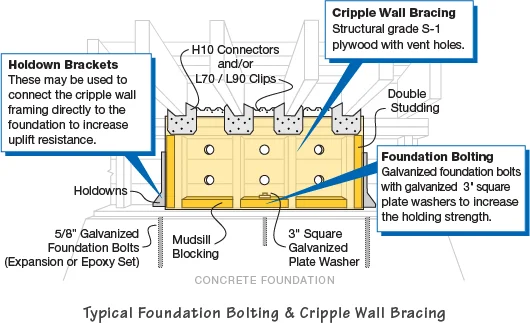
Many houses, especially those built in the 1960s and 1970s or later, are constructed with the floor framing set directly on the foundation sill. If this is the case, even if the bolting is sound, the connections may not extend far enough into the floors and walls to keep the house from sliding off its foundation.
 Homes without cripple walls
failures in past earthquake situations show the floor framing sliding off the bolted sill; a failure in the typically toe-nailed connection between bottom edge of the floor joist and the flat top surface of the bolted sill. Recently, construction technique has improved to compensate for this.
Homes without cripple walls
failures in past earthquake situations show the floor framing sliding off the bolted sill; a failure in the typically toe-nailed connection between bottom edge of the floor joist and the flat top surface of the bolted sill. Recently, construction technique has improved to compensate for this.
Wood frame structure [ edit ]
The voluntary retrofit of older residential wood frame structures is a program of the city's building and safety division that is designed to assist owners with the
seismic
upgrade of single family homes to promote public safety and welfare by reducing the risk of earthquake-induced damage to existing homes. In the aftermath of a major seismic event, those who reside in homes rendered uninhabitable by damage incurred in the initial or subsequent events will find themselves without shelter. The program has been designed to make a simple, effective and efficient way for our ventura city residents to do the retrofit on their homes that are on "unbraced cripple walls" or that are not bolted to the foundation.

Everyone knows the story of the three little pigs, each of whom built his home from a different material. While the brick house ultimately withstands the big bad wolf’s huffing and puffing, in an earthquake, you might actually be better off in the house built with sticks, as wood frame structures generally perform better in a seismic event than brick ones. This is good news for residents of the bay area, where wood frame buildings are predominant, but as mr. Lorber explains, it doesn’t rule out the possibility of catastrophic damage. “in both the ’89 loma prieta earthquake and the ’94 northridge earthquake, very few wood frame buildings collapsed completely, but we did see a good amount get shaken off of their foundations.
Awood-framed building with soft, weak or open-front walls is a multi-story wood structure where the first story is substantially weaker and more flexible than the stories above. This is typically due to lack of walls or frames at the first floor. These buildings were commonly designed prior to the 1980's and contain large open areas for tuck-under parking or commercial space, such as restaurants or convenience stores. Buildings with a soft-story condition are particularly vulnerable to severe damage and collapse during an earthquake. Without proper strengthening, the soft-story floor may suffer structural damage or complete failure during or after an earthquake.
Studies show that unreinforced masonry and concrete walls/structures are generally the biggest areas that need retrofitting. However, that doesn’t mean that other structures are completely safe. Major natural disasters like the 1994 northridge earthquake and the 1989 loma prieta earthquake showed that legacy steel structures could still fail in a major seismic event. Even if failure didn’t happen, there could be fracturing; as a result, leading to issues. As a result, people who own steel structures should give heavy thought to seismic retrofit. This is particularly important for steel frame buildings made before the mid-1990s. Buildings in this category can develop a brittle fracturing of the steel frames at the welded/riveted joints between the columns and beams.
That could mean installing steel beams or frames or a concrete wall depending on the type of building. Get southern california news, weather forecasts and entertainment stories to your inbox. Sign up for nbc la newsletters. There are two types of mandatory retrofit programs in the city of los angeles and thousands of buildings identified in need of seismic upgrades. They are what are known as soft story buildings. An example is a building with open space ground floor parking. And then there are non-ductile concrete buildings. “unreinforced concrete buildings is one type of which we have a lot unreinforced masonry buildings or non-ductile masonry buildings is another type.